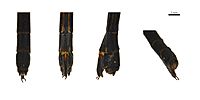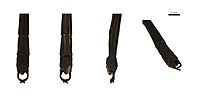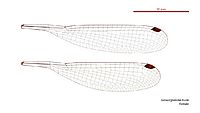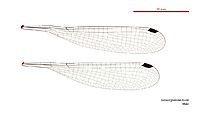Turquoise flatwing facts for kids
Quick facts for kids Turquoise flatwing |
|
|---|---|
| Conservation status | |
| Scientific classification | |
 |
The turquoise flatwing (Griseargiolestes bucki) is a special type of damselfly found only in Australia. It belongs to the Megapodagrionidae family. This amazing insect gets its common name, "turquoise flatwing," from its beautiful colors and how it rests.
This damselfly is quite unique because it is endemic to just one small area. This means it lives only in the Barrington Tops region of New South Wales. Here, it makes its home in cool, wet places like streams, marshy bogs, and damp seepages.
The turquoise flatwing is a medium-sized damselfly. It has a striking black-green metallic body with lighter markings. Its body also has a slightly powdery look, which scientists call pruinescent. Like other damselflies in its family, the turquoise flatwing rests with its wings spread wide open.
It looks quite similar to another damselfly, Griseargiolestes albescens. That species lives in coastal areas of north-eastern New South Wales and south-eastern Queensland.
Contents
What is a Damselfly?
Damselflies are fascinating insects that are often confused with dragonflies. They are both part of a group called Odonata. Damselflies are usually smaller and more slender than dragonflies. When they rest, most damselflies hold their wings together over their back. However, the turquoise flatwing is different; it rests with its wings spread out, just like a dragonfly!
How to Spot a Damselfly
You can often tell a damselfly from a dragonfly by looking at their eyes. Damselflies have eyes that are usually separated. Dragonflies, on the other hand, often have large eyes that touch each other. Both are important predators in their habitats. They help control insect populations.
Life Cycle of the Turquoise Flatwing
Like all damselflies, the turquoise flatwing goes through a cool life cycle. It starts as an egg, then becomes a nymph, and finally turns into an adult.
Eggs and Nymphs
Female damselflies lay their eggs in or near water. These eggs hatch into tiny creatures called nymphs. Damselfly nymphs live underwater. They are fierce hunters, eating small aquatic insects and other tiny creatures. Nymphs breathe using special gills located at the end of their bodies. They grow by shedding their skin many times. This process is called molting.
Becoming an Adult
When a nymph is ready, it crawls out of the water onto a plant stem or rock. Its skin then splits open, and the adult damselfly emerges. This is a truly amazing transformation! The newly emerged adult is soft and pale. It needs time for its wings to harden and its colors to fully develop. Once ready, it flies off to find food and a mate.
Where the Turquoise Flatwing Lives
The turquoise flatwing is very particular about its home. It needs clean, flowing water and specific damp areas to thrive.
Barrington Tops Habitat
This damselfly lives only in the Barrington Tops region. This area is known for its beautiful forests and clear streams. The streams, bogs, and seepages provide the perfect environment for the damselfly nymphs to grow. They also offer plenty of insects for the adult damselflies to eat. Protecting these special habitats is very important for the survival of the turquoise flatwing.
Gallery






